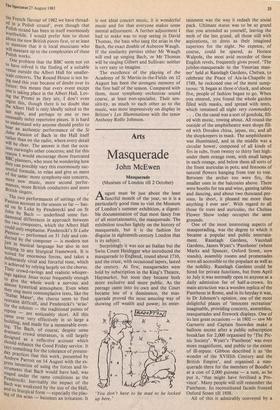Arts
Masquerade
John McEwen
Masquerade (Museum of London till 2 October)
August must be just about the least fanciful month of the year, so it is a particularly good time to visit the Museum of London's summer exhibition, a digesti- ble documentation of that most fancy free of all entertainments, the masquerade. The exhibition touches lightly on the history of masquerade, but it is the fashion for disguise in eighteenth-century London that is its subject.
Surprisingly it was not an Italian but the Swiss Count Heidegger who introduced the masquerade to England, round about 1710, and the craze, with occasional lapses, lasted the century. At first, masquerades were held by subscription in the King's Theatre, Haymarket, but soon they became both more exclusive and more public. As the peerage came into its own and the Court became less of a dominance, the mas- querade proved the most amusing way of showing off wealth and power; its enter- 'You don't have to be mad to be locked up here.' tainment was the way it redealt the social pack. Ultimate status was to be so grand that you attended as yourself, leaving the mob of the less grand, all those still with aspirations, to dress as their imagined superiors for the night. No expense, of course, could be spared, as Horace Walpole, the most avid recorder of these English revels, frequently gives proof. 'The jubilee-masquerade in the Venetian man- ner' held at Ranelagh Gardens, Chelsea, to celebrate the Peace of Aix-la-Chapelle in 1749, he reckoned one of the most sump- tuous: 'It began at three o'clock, and about five, people of fashion began to go. When you entered, you found the whole garden filled with masks, and spread with tents, which remained all night very commodely . . . On the canal was a sort of gondola, fill- ed with music, rowing about. All round the outside of the amphitheatre were shops fill- ed with Dresden china, japan, etc, and all the shopkeepers in mask. The amphitheatre was illuminated, and in the middle was a circular bower, composed of all kinds of firs in tubs, from twenty to thirty feet high: under them orange trees, with small lamps in each orange, and below them all sorts of the finest auriculas in pots; and festoons of natural flowers hanging from tree to tree. Between the arches too were firs, the smaller ones in the balconies above. There were booths for tea and wine, gaming tables and dancing, and about two thousand per- sons. In short, it pleased me more than anything I ever saw'. With regard to all those fir trees and auriculas, the Chelsea Flower Show today occupies the same grounds. One of the most interesting aspects of masquerading, was the degree to which it became a popular and public entertain- ment. Ranelagh Gardens, Vauxhall Gardens, James Wyatt's 'Pantheon' (where Marks and Spencer, Oxford Street, now stands), assembly rooms and promenades were all accessible to the populace as well as the nobility. Ranelagh Gardens could be hired for private functions, but from April to July it was normally open to anyone at a daily admission fee of half-a-crown. Its main attraction was a wooden replica of the Pantheon in Rome, and in its heyday it was, in Dr Johnson's opinion, one of the most delightful places of 'innocent recreation' imaginable, providing concerts, assemblies, masquerades and firework displays. One of its last great occasions — in 1802 — saw Mr Garnerin and Captain Snowden make a balloon ascent after a public subscription breakfast for 2,000 organised by 'The Pic- nic Society'. Wyatt's 'Pantheon' was even more magnificent, and public to the extent of ill-repute. Gibbon described it as 'the wonder of the XVlllth Century and the British Empire', and organised a mas- querade there for the members of Boodle's at a cost of 2,000 guineas — a sum, as he put it, 'that might have fertilised a Pro- vince'. Many people will still remember the Pantheon. Its reconstituted facade fronted Oxford Street till 1938.
All of this is admirably conveyed by a choice selection of prints, costumes, por- traits, jewellery, china, tickets and odd- ments, with background music by favourite composers of the time. The subject in- terestingly and, in the egalitarian spirit of masquerade, appropriately affords equal status to the likes of the painter Hudson and the composers Starzer and Eibler as to Reynolds, Zoffany or Haydn; but the most engaging aspect of all is the air of contem- porary relevance, masquerading being once more the fashion, as the briefest stroll down the King's Road or Oxford Street will abun- dantly reveal. There are clubs for today's fancy dressers but, as yet, no discernible public encouragement, in other words no Ranelagh Gardens or Oxford Street Pan- theons. Count Heidegger ended up as Master of the Revels to George II. What we need in this dawn of the age of 'service in- dustry' is clearly a Minister of Revels.



































 Previous page
Previous page